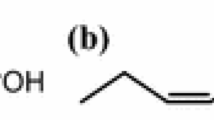Abstract
The objective of this study was to purify stearidonic acid (SDA, 18:4 ω-3) from modified soybean oil containing a mixture of over 20 fatty acids (23% SDA). Interest in obtaining purified fractions of SDA arises from reported health benefits associated with polyunsaturated fatty acids (PUFA), such as cardiovascular disease prevention. In addition, SDA may also provide improved stability characteristics since its unsaturation index is less than longer PUFA, such as eicosapentaenoic acid (EPA, 20:5 ω-3). First, a chemical ethanolysis of modified soybean oil was performed to transform the triacylglycerols into fatty acid ethyl esters (FAEE). Then, the FAEE were fractionated and SDA-EE was purified by argentation silica gel (10% AgNO3) open column chromatography, which allows selectivity based on degree of unsaturation. Different FAEE sample loads and mobile phases were explored until the best purification of SDA-EE was achieved. The solvents used were hexane and hexane:acetone mixtures (99 and 95%). Under the optimal conditions, a fraction with high SDA-EE purity (96%) was obtained with 77% yield. Besides, it was possible to obtain another fraction enriched in α-linolenic acid-EE (37% purity and 68% yield) and γ-linolenic acid-EE (22% purity and 61% yield). A scaled-up process resulted in 840 mg of final product composed of 97% SDA-EE with 71% yield.

Similar content being viewed by others
References
Kris-Etherton PM, Harris WS, Appel LJ (2002) Fish consumption, fish oil, omega-3 fatty acids, and cardiovascular disease. Circulation 106(21):2747–2757
Calder PC (2006) n-3 Polyunsaturated fatty acids, inflammation, and inflammatory diseases. Am J Clin Nutr 83(6):S1505–S1519
Fernandez E, Chatenoud L, La Vecchia C, Negri E, Franceschi S (1999) Fish consumption and cancer risk. Am J Clin Nutr 70(1):85–90
Lim GP, Calon F, Morihara T, Yang F, Teter B, Ubeda O, Salem NJ, Frautschy SA, Cole GM (2005) A diet enriched with the omega-3 fatty acid docosahexaenoic acid reduces amyloid burden in an aged Alzheimer mouse model. J Neurosci 25(12):3032–3040
Koski RR (2008) Omega-3-acid ethyl esters (Lovaza) for severe hypertriglyceridemia. Pharm Therapeut 33(5):271–303
Whelan J (2009) Dietary stearidonic acid is a long chain (n-3) polyunsaturated fatty acid with potential health benefits. Am J Clin Nutr 139(1):5–10
Jacobsen C, Let MB, Nielsen NS, Meyer AS (2008) Antioxidant strategies for preventing oxidative flavour deterioration of foods enriched with n-3 polyunsaturated lipids: a comparative evaluation. Trends Food Sci Tech 19(2):76–93
Passi S, Cataudella S, Di Marco P, De Simone F, Rastrelli L (2002) Fatty acid composition and antioxidant levels in muscle tissue of different Mediterranean marine species of fish and shellfish. J Agric Food Chem 50(25):7314–7322
Venegas-Calerón M, Sayanova O, Napier JA (2010) An alternative to fish oils: metabolic engineering of oil-seed crops to produce omega-3 long chain polyunsaturated fatty acids. Prog Lipid Res 49(2):108–119
López-Martínez JC, Campra-Madrid P, Guil-Guerrero JL (2004) γ-Linolenic acid enrichment from Borago officinalis and Echium fastuosum seed oils and fatty acids by low temperature crystallization. J Biosci Bioeng 97(5):294–298
Senanayake SPJN, Shahidi F (2000) Concentration of docosahexaenoic acid (DHA) from algal oil via urea complexation. J Food Lipids 7(1):51–61
Guil-Guerrero JL, Campra-Madrid P, Belarbi E-H (2000) γ-Linolenic acid purification from seed oil sources by argentated silica gel chromatography column. Process Biochem 36(4):341–354
Guil-Guerrero J, Campra-Madrid P, Navarro-Juarez R (2003) Isolation of some PUFA from edible oils by argentated silica gel chromatography. Grasas y Aceites 54(2):116–121
Dobson G, Christie WW, Nikolova-Damyanova B (1995) Silver ion chromatography of lipids and fatty acids. J Chromatogr B 671(1–2):197–222
Sajilata MG, Singhal RS, Kamat MY (2008) Fractionation of lipids and purification of γ-linolenic acid (GLA) from Spirulina platensis. Food Chem 109(3):580–586
Morris LJ (1966) Separations of lipids by silver ion chromatography. J Lipid Res 7:717–732
Sehat N, Yurawecz M, Roach J, Mossoba M, Kramer J, Ku Y (1998) Silver-ion high-performance liquid chromatographic separation and identification of conjugated linoleic acid isomers. Lipids 33(2):217–221
Ryu SN, Lee JD, Jeong BY, Hur HS (1997) Method for separating and purifying α-linolenic acid from perilla oil. Assigned to the Republic of Korea. Represented by Rural Development Administration. US 5.672.726 Patent (512,829)
Vázquez L, Akoh CC (2010) Fractionation of short and medium chain fatty acid ethyl esters from a blend of oils via ethanolysis and short-path distillation. J Am Oil Chem Soc 87(8):917–928
Harris DC (2007) Quantitative chemical analysis, 7th edn. W.H. Freeman, New York, pp 508–511
Acknowledgments
The authors would like to acknowledge the Grant from Monsanto Company (St. Louis, MO, USA) and the financial support from the Ministry of Science and Innovation and the Fulbright Commission in Spain, for the grant provided to Luis Vázquez to visit the University of Georgia.
Author information
Authors and Affiliations
Corresponding author
About this article
Cite this article
Kleiner-Shuhler, L., Vázquez, L. & Akoh, C.C. Purification of Stearidonic Acid from Modified Soybean Oil by Argentation Silica Gel Column Chromatography. J Am Oil Chem Soc 88, 1161–1171 (2011). https://doi.org/10.1007/s11746-011-1780-5
Received:
Revised:
Accepted:
Published:
Issue Date:
DOI: https://doi.org/10.1007/s11746-011-1780-5




